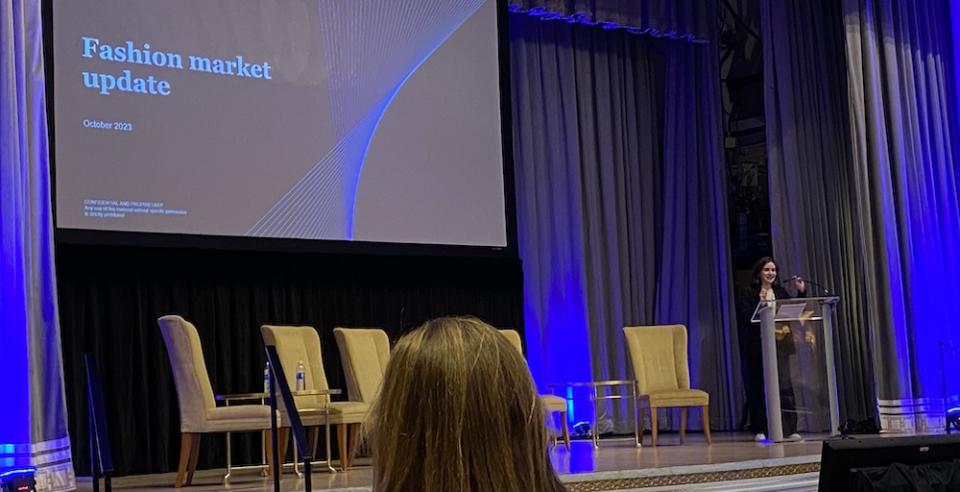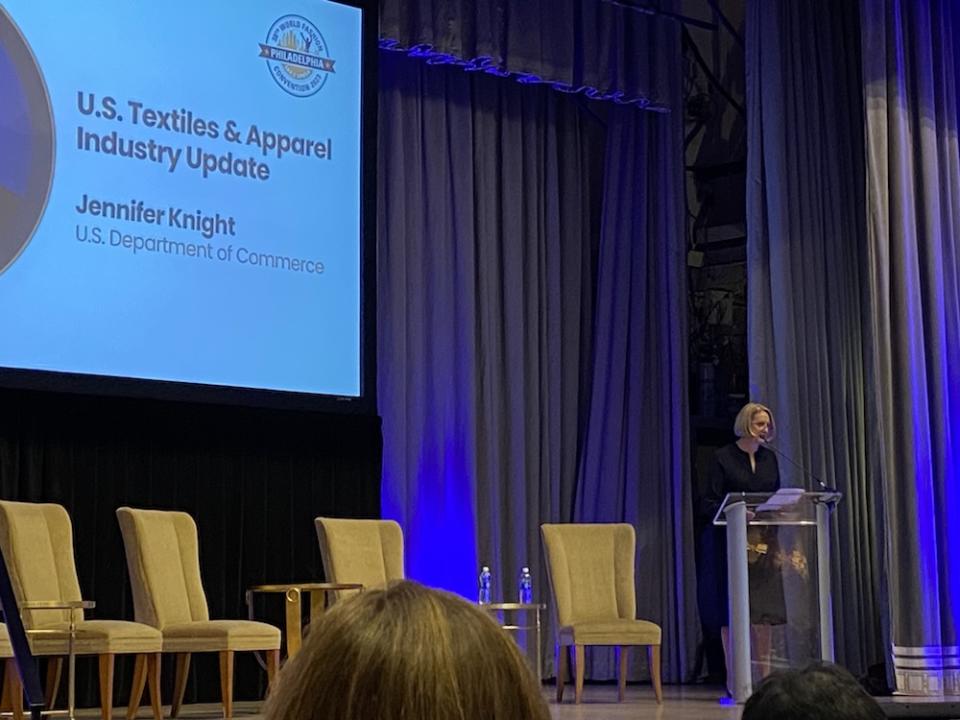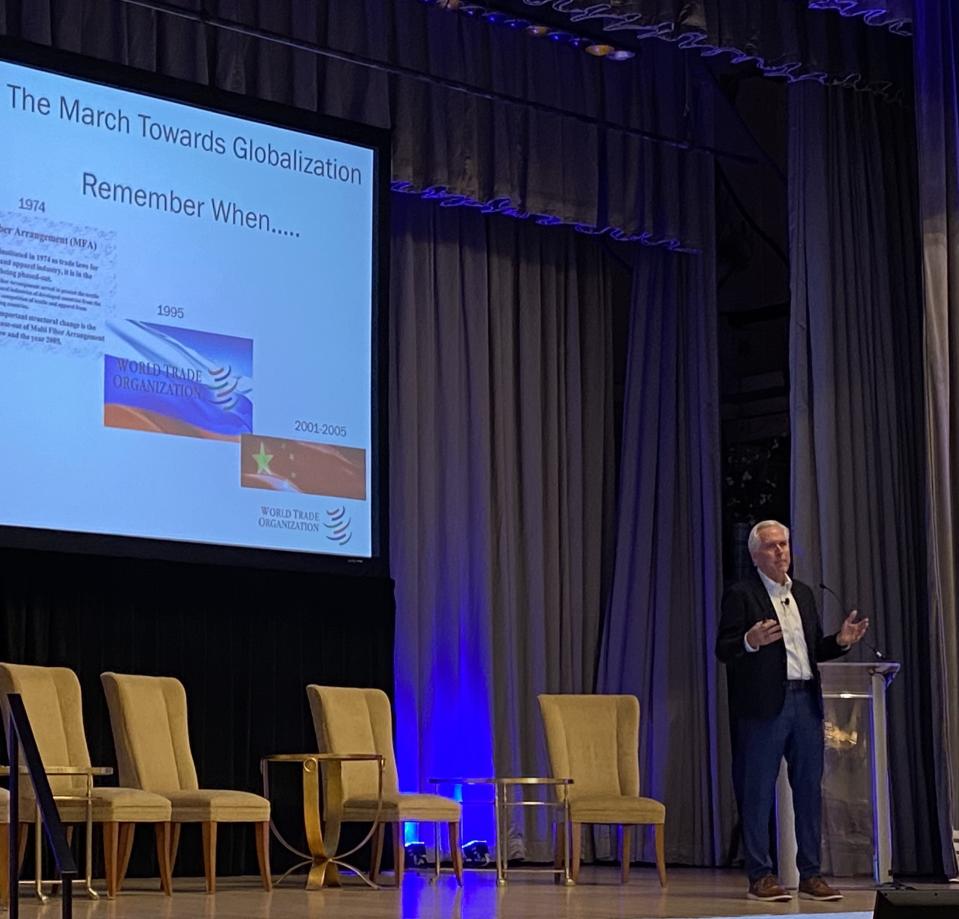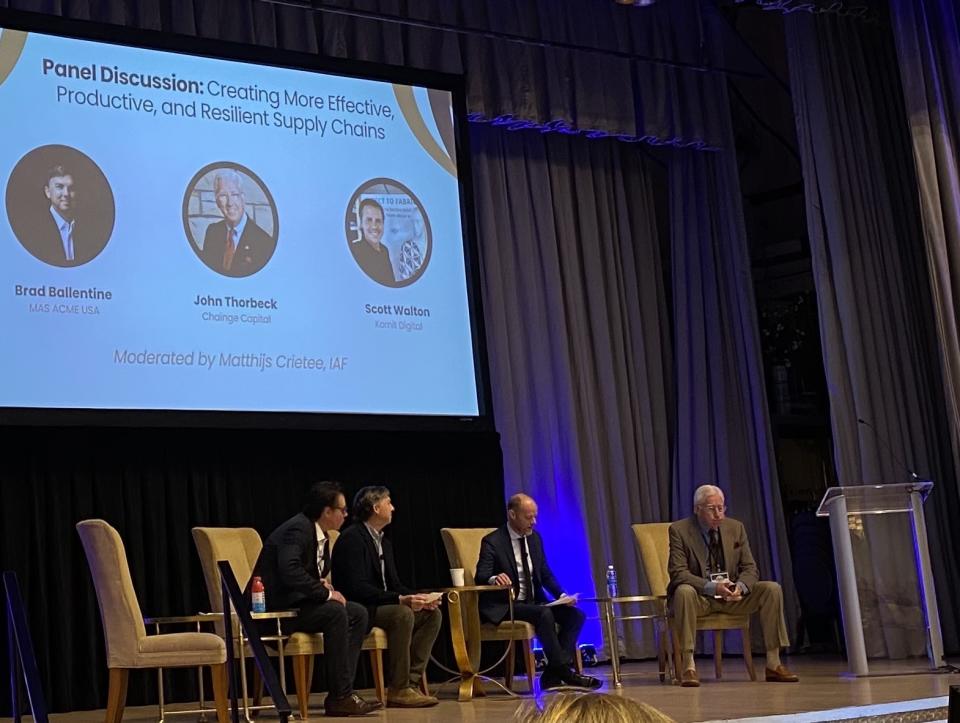Fashion’s Working to Balance ‘Long-term Value Versus Short-term Pricing’

In these uncertain times, experts say supply chains must evolve accordingly to manage disruptions and build in resiliency. At the 38th World Fashion Convention hosted last month by the Sewn Products Equipment & Suppliers of America (SPESA) and the International Apparel Federation (IAF), speakers tackled trade trends, where production is moving and new ways of working that improve efficiency.
Economic fluctuations are shaping trade, creating highs and lows. “Last year, consumers shopped a lot, so trade volume [went] up dramatically, but this year is exactly the opposite because of the weakened economy, so consumers are not spending enough to support trade growth,” said Sheng Lu, associate professor, fashion and apparel studies at the University of Delaware. He noted that in most major global markets, trade is down from last year.
More from Sourcing Journal
Africa Sourcing Veteran Explains 'Trickle-Down Effect' of Delaying AGOA Renewal
H&M, Walmart, Gap Help Better Cotton Develop Origin-Level Traceability Tool
Why J. Brooks Boutique Is One of America's Fastest-Growing Private Companies
“Whether consumers now purchase or not, it’s not simply based on how much they currently earn, but rather how they see their financial outlook,” said Lu. “The consumer’s not confident yet, therefore, fashion brands and retailers are not willing to place more sourcing orders.”
In a presentation, Petra Ghicu, management consultant at McKinsey & Company, noted that this is the first time Gen Zs and millennials have experienced this type of inflation. To navigate consumers’ varied levels of disposable income, she suggested retailers can cater to budget-conscious shoppers without harming their brand image by using outlet stores along with their higher-end mainline channels. “There’s hope for the fashion market. Consumers are still expecting to splurge on apparel, especially Gen Z and millennial cohorts,” said Ghicu. “Brands should be able to capture some of that demand.”

Shipping and supply chain management have also been concerns for the industry. During Covid, transportation disruptions became a widely experienced pain point.
“I spent the first 25 years in sourcing never really giving a darn what a container costs to tracking it daily; it was a nightmare,” said Tom Glaser, the now-retired former chief operations officer at Tapestry and president, supply chain at VF Corporation. He noted that although ports have improved, there are still high fuel costs and labor shortages in the U.S. “We’ve gone from boom to bust,” he said. “We might keep going back and forth and toggle back and forth on some of these issues as we work our way through Covid.”
With supply chains in focus, the U.S. government recently launched a supply chain center with a dedicated staff that will analyze what is happening and try to prevent potential issues, noted Jennifer Knight, deputy assistant secretary for textiles, consumer goods, materials industries, critical minerals and metals industry and analysis at the U.S. Department of Commerce.
“We’ve seen a lot of disruptions in the supply chain,” said Ghicu. “So we need to think about global production and the supply chain there in a different way. And one way that we can do that is nearshoring, vertical integration, small batch production and digitization.”
Trade talk
In a presentation, Knight explained that the Biden administration hasn’t been doing “traditional trade agreements.” She added, “We kind of needed to do a reset and think about the way we do trade agreements.”
One of the models, a “worker-centered trade policy,” focuses on ensuring that the people in the agreement countries benefit from the deals. Another model is “rebuilding alliances,” such as the Indo-Pacific Economic Framework for Prosperity.

The U.S. has free trade deals with 20 countries, mostly in the Western Hemisphere. About 17 percent of the total $25 billion U.S. apparel and textile imports come from these nations, including over $10 billion from countries under the Dominican Republic-Central America FTA (CAFTA-DR) and $6 billion from the United States-Mexico-Canada Agreement (USMCA).
Since Vice President Kamala Harris’ Call to Action for Northern Central America launched in 2021 in an effort to curb illegal immigration by creating economic opportunity in the region, it has spurred $4.2 billion of investment, a third of which is apparel focused.
“In the last 30 years, each of these countries, Guatemala, Honduras and El Salvador, has really established itself as a player on the global stage in terms of apparel, and now we’re starting to see more textile investment,” Knight said. “They have a lot of potential and [I’m] personally an optimist, and I hope that we will see their market share continue to grow.”
One trade deal that the industry is watching closely is the African Growth and Opportunity Act (AGOA), which is set to expire in 2025. “Everyone’s optimistic that renewal is going to happen, everyone wants it to happen as soon as possible for as long as possible,” said Marc Hansult, co-founder and co-CEO of DTRT Apparel Group, which produces in Ghana. Explaining the importance of the trade deal, he added, “I think there’s people really waiting for that very strong signal that would come through AGOA renewal to make significant investment in our industry in Sub-Saharan Africa.”
Ethiopia lost its AGOA beneficiary status in early 2022, showing the potential impact that a broader end to the trade deal could have in Africa. Jessica Ramey, CEO of Mercantilia Consulting, which sources and develops products with artisans and small factories across Africa, called the loss of AGOA in Ethiopia “absolutely devastating.” Some companies exited the country. “We didn’t leave, we kept all of our production, but the duty costs to the U.S. had a huge impact on our profitability,” she said.
Diversifying the sourcing map
For decades, fashion supply chains have been spreading across the globe, and Glaser noted the economic impact this strategy has had as it began an “industrial revolution” in countries. “Globalization really reduced the defining poverty around the world,” he said, pointing to Bangladesh as “one of the biggest success stories.” The country today has a higher GDP per capita than India. “Apparel is the oil of Bangladesh,” he said.

Lately, diversification has stemmed from companies looking to reduce their exposure in China, moving production to other nations like Vietnam and Bangladesh. Per Knight, China’s share of imports to the U.S. has decreased in 2023 from 27 percent to 21 percent, at the same time that other regions have been growing by double digits. Glaser predicts that Vietnam will become the biggest apparel supplier to the U.S. in the future due to China tariffs, rising wages there, and move toward higher-value industries.
Lu noted, however, that China has “unique advantages” that put it ahead of other Asian nations, making it difficult to completely leave the country. Among the benefits of China is low or no minimum order quantities (MOQ), compared to high minimums for its peers. China has also become a textile supplier, expanding beyond apparel manufacturing.

As companies diversify their sourcing map, they have also consolidated the number of vendors they work with since 2019 and they are giving their top suppliers more orders, per Lu. This might include working with “super vendors” with a multi-country presence or vertical infrastructure. In a panel on “Manufacturing in Emerging Markets,” Alejandro Ceballos, president of Guatemala apparel organization VESTEX, noted that most of the companies operating in Central America are Korean-owned, and they have been integral in creating clusters and improving cost efficiency.
“We see a lot of people moving or looking to produce closer to the U.S. market,” said Karin De León, investment director of VESTEX and executive director of the Central American-Dominican Republic Council of Textiles and Apparel (CECATEC-RD). “And a lot of customers start to push their vendors to [look] for a place in that Central America region.” This includes companies from China, Sri Lanka and Vietnam.
Hansult noted that East Africa is similarly seeing investment from other parts of the world, such as China, Turkey and the United Arab Emirates.
For countries that want to gain more ground in the apparel market, Knight suggested focusing on product capabilities, quality, sustainability and speed to market.
West Africa first attracted Hansult due to its proximity to the U.S. and Europe, which enable faster turns. “Speed to market, of course is critical to be competitive and to actually capture some of that market share, that piece of the pie that’s moving out of China,” he said. The region is also boosting its position by establishing a “vertical ecosystem.”
One thing Ramey has seen develop in Kenya is a “collaborative spirit” among artisan producers, which has enabled the creation of entire products locally, rather than shipping out pieces for construction and assembly elsewhere. “Those different artisan groups are actually coming together and learning from one another,” she said. Ramey also works for the brand Lemlem, which has leaned into a slow fashion model out of necessity, due to its artisan, handmade production approach, and it recently adjusted its development calendar accordingly.
For nearshoring, Yusuf Amdani, chairman of GK Global, said he does not see Mexico as a “fit anymore for textiles.” He added, “Mexico is getting a huge influx of companies in every other industry, and for textile to compete is very difficult.” He added that Central America will “remain viable for a time to come.”
Sharing this positive outlook on Central America, Ceballos noted that for U.S. companies, the region’s nearness is a plus for supply chain management, allowing executives to visit quickly when needed. “The opportunities are there and the capabilities are there, and they are growing,” he said.
Reshaping sourcing relationships
Speakers also pointed to the need for a change in sourcing practices.
“For a long time…we were marauders, we went all over the damn world looking for the lowest cost, in the lowest country, with the lowest raw material costs,” said Glaser. “Basically, we went after cost and efficiency.” He noted that today, there are factories that will offer very low prices to get business, but companies should “resist” in favor of strategies that support agile supply chains. “We need to think about long-term value versus short-term pricing,” he said.
In a panel on “Creating More Effective, Productive, and Resilient Supply Chains,” John Thorbeck, chairman of Chainge Capital, spoke about a report supported by the International Trade Center that presents a business model that uses “process and productivity” innovation to “reimagine upstream value.” He stated that inventory represents risk as well as capital, and called for curbing overproduction to unlock an “enormous financial opportunity,” including more funds for sustainability.
“Shared risk elevates a supply chain perspective, end to end, in all tiers of the supply chain,” said Thorbeck. “And it is meant to complement a financial point of view in shared value, and an organizational point of view in shared purpose.”

Manufacturer MAS has been able to “change the narrative.” Brad Ballentine, CEO of MAS ACME, explained that the company has focused on using process innovation to solve two of the biggest cost risks for retailers: markdowns and stockouts. Sharing an anecdote about pitching a retailer, Ballentine said MAS won the business by differentiating itself on a nimble operating model that could improve full-price sell-through while competitors led with product quality.
One of the ways that MAS has built in more flexibility is with postponement, or buying greige material and then dyeing it based on point-of-sale data. Instead of the usual 12-month development cycle, postponement offers a 12-week timeframe. Ballentine noted that there are some “tradeoffs” of this model. For one, material choices must be edited. “You cannot postpone unlimited options, so postpone a piece of your business,” he said.
Printing machine manufacturer Kornit Digital is also supporting agility and late decision-making through predominantly onshore printing. This on-demand capability helps companies react to and capitalize on increasingly fast trend cycles. It also offers an opportunity to test out styles and replenish quickly if they perform well.
“We need to digitize the full value chain all the way through to the manufacturer,” said Scott Walton, head of global business development brands at Kornit Digital. “Because that increasing uncertainty will continue.”

